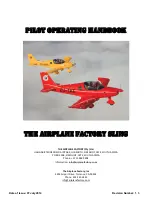
Sinus 912 LSA Glider 550 MTOW
www.pipistrel.eu
REV. 3
Appendix
Before turning to base-leg, reduce power to idle and set flaps to 1
st
stage at 60 kts (110 km/h).
Once out of the turn, reduce speed towards 55 kts (100 km/h). Power remains idle from the point of
turning base all the way to touch-down. If you plan your approach this way, you will always be on
the safe side - even if your engine fails, you will still be able to safely reach the runway!
Turn to final at 55 kts
(100 km/h)
. When in runway heading, set flaps to 2
nd
stage.
Operate the air-
brakes to obtain the desired descent path (if applicable).
How to determine how much airbrakes you need for a certain airspeed?
Open them half-way and observe the runway. If the runway threshold is moving up, you are drop-
ping too fast - retract the airbrakes a little. If the runway threshold is disappearing below your
aircraft, you are dropping too slowly - extend airbrakes further.
When working on airbrakes, it is
important to keep the airspeed/pitch angle constant throughout final all the way to flare! The
airbrakes will not impact your speed, just rate (angle) of descent.
For pilots who are not used to
operating airbrakes but throttle instead, keep in mind that airbrakes in Sinus work just like throttle
does: handle back equals less throttle, handle forward equals more throttle.
CAUTION!
Never drop the airbrakes handle when using them, keep holding the handle even
if you are not moving it!
Roundout (Flare) and touchdown
Your speed should be a constant 55 kts (100 km/h) throughout the final with the descent path
constant as well.
At a height of 10 meters
(25 feet)
start a gentle flare and approach the
aircraft must
touch down with the main (back) wheels first,
so that you will not bounce on the runway. After
touchdown, operate the rudder pedals if necessary to maintain runway heading and try to have the
nose wheel off the ground for as long as possible. When the nose wheel is to touch the ground, rud-
der pedals MUST be exactly in the middle not to cause damage to the steering mechanism.
While
braking, hold the stick back fully!
Once you have come to a standstill, retract flaps all the way to
negative position (handle full down) and retract and lock the airbrakes - handle full up.
Should you bounce off the runway after touch-down, do not, under any circumstances, push
stick forward or retract airbrakes.
Spoilers (airbrakes) stay fully extended, the stick goes backwards
slightly. Bouncing tends to reduce by itself anyhow.
Crosswind landings, depending on the windspeed, require some sort of drift correction. Most
efficient is the low-wing method, where you are to lower the wing into the wind slightly and main-
tain course by applying appropriate rudder deflection. You can also try the crab method.
Crosswind landings on paved runways
(asphalt, concrete, tarmac...)
In this case, special attention must be paid to straightening the aircraft before touchdown
in or-
der not to damage the undercarriage because of increased surface grip on impact.
Should the crosswind component be strong (8 kts and over), it is recommended to gently
flare in
such a manner, that one of the main wheels touches-down an instant before the other
(e.g. if
there is crosswind from your left, the eft wheel should touch down just before the right wheel does).
This way the undercarriage almost cannot be damaged due to side forces on cross-wind landings.
Landing in strong turbulence and/or gusty winds
First of all
airspeed must be increased
for half of the value of wind gusts (e.g. if the wind is gusting
for 6 kts , add 3 kts to the final approach speed). In such conditions I would also recommend to only
9-10







































